Explore the timeline below, and take a journey through 175 years of the Brooke family's relationship with Sarawak. Click on the + and view evocative imagery and a deeper narrative.
Sultanate of Brunei established, with control over Sarawak
+- 1476

With an empire extending as far as the Philippines, in the 1500s the sultanate of Brunei was one of the most powerful Malay states in South East Asia.
Ferdinand Magellan’s first circumnavigation of the globe
+- 1519–22

Brunei’s influence was at its height when the Portuguese navigator Ferdinand Magellan’s expedition called there in 1521.
Sarawak is first recorded on a European map
+- 1537

Before the 1800s Europeans knew little about Borneo, the world’s fourth largest island.
Antimony ore is discovered on the Sarawak River
+- 1826

The discovery of antimony ore on the upper reaches of the Sarawak River had sparked European interest. By 1826 antimony was needed in Europe for metal alloys and fetched a high price. Brunei was keen to tax the profitable trade.
James Brooke born in Bendal, India
+- 1803

James Brooke was born in India in 1803, the fifth child of Thomas Brooke, a high court judge, and Anna Stuart. Educated in England, he joined the East India Company as a military officer. On being wounded in the First Burmese War of 1824, he resigned his commission.
Beginning of Sarawak rebellion against the Sultan of Brunei
+- 1835

Brunei’s renewed interest in Sarawak for its antimony exports had led to oppressive taxes on the local population. The Bidayuh (formerly known as Land Dayaks) and Malay inhabitants of the province began waging a fitful rebellion, fighting for independence from their Bruneian rulers.
Thomas Brooke dies, leaving £30,000 to his son James
+- 1836

James Brooke purchased a 142-ton schooner in 1836, with money inherited from his father, envisaging a voyage of adventure and scientific exploration.
James Brooke sets sail for the East aboard Royalist
+- 1838

After zoological briefings by the Natural History Museum in London, and with support from the Royal Geographical Society, Brooke set sail from Plymouth in 1838, arriving at Sarawak the following year. It was a bold private venture that would change the course of Sarawak’s history.
James Brooke arrives in Kuching aboard the Royalist
+- 1839

This would have been the view that greeted James Brooke on his arrival in Sarawak. He described Kuching as consisting of ‘brown huts and long-houses made of wood … sitting in brown squalor on the edge of mudflats’.
Political authority over Sarawak ceded to James Brooke by Rajah Muda Hassim. State of Sarawak founded
+- 1841

Brooke’s arrival offered the Sultan’s special emissary, Rajah Muda Hassim, a solution: if Brooke defeated the rebels he would be granted political control of Sarawak. The rebel leaders surrendered on the understanding that James Brooke would become Rajah of a Sarawak that was independent of Brunei.
Sarawak flag hoisted for the first time
+- 1848

Now ruler of an independent Sarawak, Brooke designed for the state its own flag, based upon the Brooke coat of arms.
Rev. Francis McDougall and his wife Harriet arrive in Kuching as first Anglican missionaries
+- 1848

The first Rajah encouraged Anglican missionaries to Sarawak in the belief that converting the Dayaks to Christianity would help them settle in peaceful communities.
Sarawak is recognised by the United States
+- 1850

Although the British government was content for James Brooke to govern Sarawak as Rajah, it was initially unwilling to grant the state official recognition. The United States was the first country to grant such recognition.
Naturalist and collector Alfred Russel Wallace arrives in Kuching
+- 1854

Many well-known naturalists, including the Englishman Hugh Low and the Italian Count Odoardo Beccari, came to prominence in the mid-to-late 1800s through their work in Sarawak. The most important naturalist to visit Sarawak, however, was Alfred Russel Wallace, co-proponent of the Theory of Evolution and its probable mechanism, Natural Selection.
Supreme Council established
+- 1855

As the first ‘White Rajah’ of Sarawak, James Brooke quickly set about establishing a modest form of government, combining existing practices and customs with his own liberal humanitarian ideals. From the outset he ruled by means of a forum of local Malay datus (chiefs) and European officers that constituted the Supreme Council (European members were never to outnumber native members).
Borneo Co Ltd is established
+- 1856

Sarawak’s economic future seemed promising with the establishment of the Borneo Company. The Company acted as banker to the Sarawak government before banks were established and provided it with badly needed loans during the early years.
Kuching is sacked by 600 Hakka miners from Bau
+- 1857

The Hakka community in Sarawak was small but important. Many were gold miners, settled in Bau, who had fled from Dutch Borneo. After a dispute arose between the miners and the government over taxation of opium and gold exports, 600 armed miners came down the Sarawak River to Kuching, gaining control of government buildings. However, with the arrival of a Borneo Company steamer and a Dayak force from Lingga, the miners were defeated with heavy losses.
Angela Burdett Coutts extends loan to Sarawak
+- 1859

The millionaire banker Angela Burdett-Coutts was a loyal friend and admirer of Rajah James Brooke, funding many of his enterprises, including the armed steamer Rainbow and an experimental farm at Matang. The couple exchanged countless letters and it is thought that she offered him a proposal of marriage, one that Brooke politely refused. The cockatoo was believed to have been given to her by Rajah James.
Sarawak is recognised by Britain
+- 1863

By the time Britain granted Sarawak official recognition it had been an independent kingdom for more than two decades, It would be a further two decades before Britain would offer official protection to the fledgling state.
Rajah Muda John Brooke Brooke disinherited and banished
+- 1863

Captain John Brooke Johnson, better known as Brooke Brooke, was James Brooke’s nephew, and Charles Brooke's elder brother. He joined Rajah James Brooke’s service in 1848 and quickly won his trust, frequently acting in his place when he was absent. In early 1861 he was declared Rajah Muda, or heir apparent, in a formal ceremony in Kuching. Shortly afterwards, however, he came into conflict with James over plans for Sarawak’s future.The Rajah disinherited him, banning him from setting foot in Sarawak again. Brooke Brooke returned to England a broken man; all attempts at reconciliation with the Rajah were in vain and they died within months of each other.
First meeting of Council Negri at Bintulu
+- 1867

Larger and more representative than the Supreme Council, the Council Negri was created during the reign of the first Rajah but was primarily implemented by the second. Under Rajah Charles Brooke, it was a more formal occasion for which members of the Supreme Council, other European officers and native chiefs from all over Sarawak would gather. Although it is run quite differently now, the Sarawak Council Negri is Malaysia’s oldest legislature.
James Brooke dies at Burrator and is buried in Sheepstor Churchyard
+- 1868

James Brooke retired to Burrator, on the edge of Dartmoor and died there, leaving the Raj to his younger nephew Charles. He had lived an extraordinary life, defied the odds and made history.
But while his Sarawak achievement might have won him fame, it produced no vast fortune: the English probate value of James Brooke’s estate upon his death was under £1000.
Charles Brooke proclaimed second Rajah
+- 1868

On Brooke Brooke's dismissal, the Rajah appointed Charles in his place and he served as an outstation officer for over ten years before becoming the second Rajah. His time spent among the Dayaks as a young man gave him a unique appreciation and love of their culture (he outraged the European community of Kuching by returning from upriver attired in traditional costume). He continued the work his uncle had started, suppressing piracy, slavery and head-hunting, while encouraging trade and development and expanding the borders.
Marriage of Charles Brooke and Margaret de Windt
+- 1868

Marriage to the second Rajah, Charles Brooke, propelled the nineteen-year-old Margaret de Windt into a world of adventure. An advocate of universal education, she established the first school for Malay boys and helped to liberate Malay women through increased access to literacy. Her diplomacy when in England elevated the status of Sarawak abroad, keeping it in the public eye.
First Sarawak stamps issued
+- 1869

Crudely printed currency notes were in circulation by 1858. Each of these uniface notes was printed on handlaid paper, stamped with the seal of the Sarawak Office of Registry, as well as a handwritten date and the signature of Charles Adaire Crymble, the treasurer. The first Sarawak postage stamps, bearing Brooke’s portrait, were printed in 1868, the year of his death.
Astana is completed
+- 1870
After Rajah Charles Brooke’s major additions in the late 1860s, including a crenelated tower, the royal palace in Kuching, known as the Astana, became an icon of Brooke authority. Sarawak’s official motto, Dum Spiro Spero (‘While there is life, there is hope’), taken from the family coat of arms, could be seen in jawi script above the main entrance.
First Sarawak Regatta takes place
+- 1872

The annual Sarawak Regatta, dating from 1872, began as a means of defusing Dayak inter-tribal conflicts. Rajah Charles Brooke encouraged local tribes to challenge each other through boat races to prove their power and skill. The Regatta was also a Red Letter day in the social calendar for outstation officers, providing a chance to renew old friendships.
Ranee Margaret composed Sarawak Anthem
+- 1872

The Sarawak Anthem was composed by Ranee Margaret (or Ghita, as she was known) in honour of the first Rajah, James Brooke. She dedicated it to her husband and second Rajah, Charles Brooke. ‘Gone Forth Beyond the Sea’ was used as Sarawak’s national anthem for the next seventy years.
Opening of new Courthouse, Kuching
+- 1874
Perhaps the best representation of Rajah Charles Brooke’s government was the Courthouse, which opened in 1874 and brought together all departments under one roof. Its layout echoed a Malay kampong (village) with a series of pavilions arranged around a common space. Although Western architectural references are made in the colonnaded verandahs, they were used in a practical way. Locally fired bricks were used for the cement-rendered and whitewashed walls.
Charles Vyner Brooke, Rajah Muda, is born
+- 1874

Charles Vyner de Windt Brooke was eldest surviving son of the second Rajah. In 1897 he entered the Sarawak Government Service. Relations with his father were strained from the outset with Charles convinced that Vyner was unsuited to the task of ruling Sarawak. Striking to look at, with the physique of a boxer and startlingly pale blue eyes , his appearance could be unsettling, which he sometimes used to advantage. He shared his father’s affection for Sarawak but disliked the trappings of ceremony and was crippled with shyness during official events.
Bertram Brooke, Tuan Muda, is born
+- 1876

The second of Rajah Charles and Ranee Margaret Brooke’s three surviving sons, Bertram Willes Dayrell Brooke was the studious and responsible one, taking a rowing blue at Cambridge and serving as a captain in the Royal Horse Artillery. In 1904 he married Huntley & Palmer heiress Gladys née Palmer, with whom he had a son and three daughters. Affectionately known by his university friends as ‘Rajah’, and by his family as ‘Adeh’ (younger brother), a close friend described Bertram Brooke as ‘the most loveable and purest person I have ever known’.
Great Fire of Kuching
+- 1884

Civic buildings constructed during Brooke rule represented in tangible form the philosophy of the Raj. In stark contrast to British colonial architecture of the time, the Brookes adapted local building design and used local materials, construction methods and workers. The result was a hybrid mix of European, indigenous and immigrant styles. Following a fire in which much of the city was destroyed, Charles ordered all future buildings to be made of brick.
Treaty of Protection signed with Britain
+- 1888

Concern that Rajah Charles Brooke might take over what remained of the Sultanate of Brunei led to a Treaty of Protection whereby Britain took responsibility for Sarawak’s security and foreign relations but allowed full autonomy in internal affairs. Under this treaty Charles vigorously defended Sarawak’s sovereignty from any attempts to extract concessions or extend influence.
Sarawak Museum is officially opened
+- 1891

A museum intended to showcase Sarawak’s cultural and natural diversity was initiated by Rajah Charles Brooke in 1888. Its first collection had been assembled by naturalist Hugh Brooke Low. Charles took great pride in the new institution, which aspired to be ‘second to none in the East’. The purpose-built museum, which still stands in Kuching’s Central Padang, opened officially in 1891.
Peacemaking at Marudi 1899
+- 1899

In 1863 Rajah Charles Brooke had led a bala (army) of 15,000 Dayak volunteers against the Kayan people of the upper Rajang River, who had been attacking Dayak longhouses downriver. In concluding the peace-making in late 1863, Brooke considered Sarawak to be ‘without an enemy in her dominions and without an inter-tribal war of any description.’ Later negotiations brought further peace-making ceremonies, notably that at Marudi, pictured here.
Oil drilled at Miri in north-east Sarawak
+- 1910

The economy was dramatically boosted in the early 1900s by the motorcar and the subsequent demand for rubber for tyres, but it was the discovery in 1910 of petroleum at Miri, on the north-east coast, that secured Sarawak’s economic future.
Marriage of Bertram Brooke and Gladys Palmer
+- 1904

Gladys was the only child of Sir Walter Palmer and Jean, Lady Palmer, and thus heiress to the Huntley & Palmer biscuit fortune.She was brought up in a Bohemian world filled with artists, writers and actors, such as Philip Burne-Jones, Ellen Terry and Sarah Bernhardt. Gladys’s relationship with her father-in-law was a happy one, with Rajah Charles doting on his grandchildren. During her lifetime Gladys underwent a number of religious conversions. finally converting to Islam in the Paris Mosque in 1932, after which she went by the name of Khair-ul-Nissa (Lady of Peace).
Marriage of Charles Vyner Brooke and Sylvia Brett
+- 1911

Sylvia Brett was the younger daughter of Eleanor van de Weyer and Lord Esher, a senior courtier who served as Private Secretary to Edward VII and George V. Her marriage to Vyner was bitterly opposed by Vyner’s parents, Rajah Charles and Ranee Margaret who feared the effect the marriage might have upon Sarawak, and the possibility that Vyner might be persuaded to hand over Sarawak for plantation and mining development. While her unusual status and activities were celebrated by the press, the Colonial Office had long regarded her as 'a dangerous woman'.
Anthony Brooke is born
+- 1912

The year 1912 marked the birth of Gladys and Bertram’s longed-for son, Anthony. On hearing the news Rajah Charles Brooke immediately ordered a 21-gun salute. As next in line to the throne after Bertram, and with Sylvia unable to produce a male heir to take his place, Anthony's birth would prove a major source of friction between members of the Brooke family.
Brooke Dockyard opens
+- 1912

In place of the informal arrangements under the first Rajah, Charles established proper government departments – Customs and Excise, alongside the Treasury and Public Works. In the twentieth century, modern technology reached Sarawak, with the establishment of a dry dock (this view shows the Rajah’s yacht, HHY Zahora), together with a network of lighthouses, radio communication towers, waterworks and even a railway.
Rajah Charles address to the Council Negri
+- 1915
A radical in his political views, Rajah Charles was openly critical of British Imperial policy, declining a baronetcy from the King in 1911 and issuing a pamphlet in which he deplored the way Britain governed her colonies by power, and not by what he called a ‘friendly intercourse of feeling’. Shortly before he died he issued a moving address to the Council Negri, his last, in which he warned against 'strangers and speculators' who after his time might appear 'with soft and smiling countenances' to deprive the people of their birthright.
Rajah Charles writes his Political Will
+- 1915

By the time he died in 1917 Charles Brooke had lived in Sarawak for sixty years, fifty of those as Rajah. Reflecting his strong preference that Bertram should inherit the Raj rather than his older brother Vyner, Rajah Charles’s political will of 1912 set out a power-sharing arrangement by which the two brothers were to take alternate control of the government for six months of the year.
Rajah Charles Brooke dies in England and Vyner Brooke is proclaimed Rajah
+- 1917

The challenges facing Vyner were very different to those of the two previous Rajahs. By 1917 the country was at peace and the economy and provision of education, health and other services dominated. Prices for rubber and pepper had plummeted with the Depression and the independence of outstation officers had to be reconciled with a need for centralisation.
Bertram Brooke is appointed to co-rule Sarawak, alternating with his elder brother
+- 1917

Rajah Charles Brooke made no secret of his preference for his second son Bertram. Offered the succession by his father, Bertram declined but agreed to share power with his elder brother. Vyner was duly installed as Rajah with Bertram assuming control of the government of Sarawak for half the year. Bertram gradually handed over Sarawak affairs to his son, Anthony, in the late 1930s, whilst retaining his official status under Rajah Charles’ will as Tuan Muda (heir presumptive).
Marriage of Anthony Brooke and Kathleen Hudden
+- 1939

Kathleen Hudden met Anthony Brooke through her brother Donald, who served for many years as district officer at Marudi in Sarawak. One of the most popular of all the Brooke officials, he would later be killed in 1942 in Dutch Borneo at the instigation of Japanese forces early in the Second World War. Kathleen and Anthony married in Rangoon, Burma, in 1939, later raising a family of one son, James, and two daughters, Angela and Celia. Kathleen would soon come to know of the difficult relationship between Anthony and his uncle Vyner, the third Rajah, a major cause of which was Vyner Brooke’s lack of an heir.
Appointment of Anthony Brooke as Rajah Muda
+- 1939

Educated at Eton, Cambridge and the University of London’s School of Oriental and African Studies, Anthony served in the Malayan Civil Service and joined the Sarawak Service in 1936. After spells at the outstations of Nanga Meluan and Marudi, and at the Kuching Secretariat, he returned to England in 1938 to study colonial administration at Oxford and complete his preparation for becoming Rajah of Sarawak.
James (Lionel) Brooke is born
+- 1940

James Brooke, known as Lionel, was born the only son of Anthony and Kathleen. He spent a period of time in Sarawak during his father’s term of rule, before being evacuated to England on the eve of the Japanese invasion. Known as 'Rajah' at school, and raised with short-lived prospects of rule, James would go on to study at Eton College, Berkshire, and Grenoble University, before embarking on a successful career as a racing car driver.
Centenary of the Brooke Raj in Sarawak. Proclamation by Rajah Vyner that Sarawak is to have written Constitution
+- 1941

In September 1941 the people of Sarawak commemorated 100 years of Brooke rule at a time when Europe was embroiled in full-scale war and there was nervousness about Japan’s intentions. Despite the sense of foreboding, the celebrations went ahead with much pageantry, including a fancy-dress ball and a special regatta. On the occasion of the celebration Vyner signed a written constitution, which in theory paved the way for self-government by the people.
1941
+- Japanese forces capture Kuching

In late 1941 Japan embarked on an ambitious campaign of territorial expansion in the Pacific and South East Asia. The intention was to neutralise American, British and Dutch forces, seize regions rich in economic resources, and secure an outer defence line for the Japanese Empire. On 8 December Sarawak’s tranquillity was shattered when a Japanese invasion force entered Miri. Ten days later, Japanese aircraft bombed Kuching. By Christmas Day, the town had fallen to the invaders and the remainder of the state, together with Brunei, North Borneo and Dutch Borneo, was in Japanese hands by February 1942.
Sarawak Provisional Government in Exile is established in London
+- 1944

When Japanese forces invaded Sarawak in December 1941, Vyner was on holiday in Australia. He attempted to return to Sarawak but was forced to spend the next two years in Melbourne, appointing Anthony head of the Sarawak Provisional Government-in-Exile in London.
Sarawak is liberated by Australia’s 9th Division
+- 1945

In February 1945 a joint British/Australian guerrilla unit (known as SRD or ‘Z Force’) parachuted behind the lines into Sarawak’s highlands to harass the Japanese, training and arming indigenous tribes who were encouraged to take Japanese heads. On 11 September 1945 Sarawak was liberated by Australia’s 9th Division.
Rajah Vyner resumes civil administration of Sarawak
+- 1946

The ceremony represented the restoration of Brooke sovereignty following liberation. Just a month later, however, Rajah Vyner Brooke was to cede his rights to Britain. The Datu Patinggi (grandson of Datu Patinggi Ali), who supported Anthony Brooke’s succession as Rajah Muda, would become the key figurehead of the anti-cession movement.
Rajah Vyner announces intention to cede Sarawak to Britain
+- 1946

In the aftermath of war, liberation was swiftly followed by political upheaval. In October 1945, Rajah Vyner Brooke had bowed to British government pressure and ceded his rights over Sarawak to the British Crown.
Sarawak annexed by Britain as a Crown Colony
+- 1946

On 1 July, Malcolm MacDonald, Britain’s new High Commissioner for South East Asia, officiated at the formal proclamation of the annexation of Sarawak as a British Crown Colony, marking the end of Sarawak’s independent statehood.
Anti-Cession Movement is formed
+- 1946

Newly formed Malay and Dayak political associations defied the move, giving rise to a campaign to restore Brooke rule under Anthony Brooke and maintain Sarawak’s political autonomy.
Anthony Brooke is banned from Sarawak
+- 1946

Banned from entry to Sarawak by the British colonial authorities, Anthony Brooke established himself in Singapore to support the anti-cession campaign.
Free Sarawak Flag is flown over 'Sarawak Lodge' Singapore
+- 1946
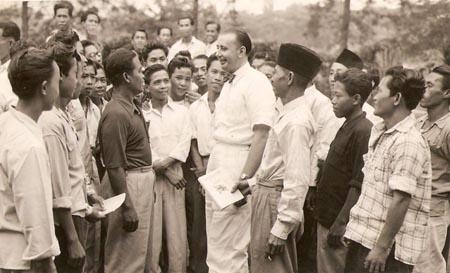
‘As St George stands for England, so a Brooke is to us. Do not fail us.’ So wrote Philip Jitam, President of the Sarawak Dayak Association, to Anthony Brooke. His letter was later included in The Facts about Sarawak. Published privately and distributed to Members of Parliament and the press in Britain, this pamphlet comprised important documentary evidence in support of the campaign to overturn the 1946 annexation of Sarawak by Britain.
Mass protests take place in Sarawak
+- 1947

This photograph of young people demonstrating became one of the most enduring images of the anti-cession movement.The anti-cession movement, loyal to Rajah Muda Anthony Brooke and initially led by Datu Patinggi Abdillah and his Malay National Union, fought a long, brave, constitutional battle to repeal the cession.
Sarawak Civil Servants resign
+- 1947

‘By taking this step we sacrifice our means of living and worldly happiness to show that we are determined to protest the cession of our country and to defend its independence under the Rajah Brooke dynasty.’ So declared the anti-cessionists, upon whom the British colonial authorities came down heavily. A warning was issued to government employees that they would be liable to dismissal if they committed any act of disloyalty to the government or associated with anti-cession activities. Always advocating non-violent resistance to restore independence, in response to this order, known as ‘Circular no. 9’, 338 civil servants resigned from government service.
Governor Duncan Stewart is assassinated
+- 1949

The anti-cession cause was repeatedly frustrated by the hard-line administration of the first British Governor, Sir Charles Arden Clarke. The campaign continued constitutionally until a radical splinter group of thirteen, known as Rukun 13 (thirteen pillars) lost patience with its progress and plotted to assassinate the newly appointed second British Governor, Duncan Stewart. At Sibu, on 3 December 1949, the nineteen-year-old Rosli Dhobie rushed out of the crowd with a kris and stabbed the Governor, who died of his wounds one week later. This dramatic climax effectively brought the anti-cession campaign to an end.
Anthony Brooke announces temporary halt to campaign
+- 1951

Fearing the spread of Communism to the region, and not wanting his involvement to provoke further bloodshed, Anthony Brooke, Rajah Muda of Sarawak, withdrew from the anti-cession campaign in 1951 at the height of the Cold War. This effectively marked the end of Brooke political involvement in Sarawak. Anthony Brooke would go on to advise the British government on constitutional matters leading up to the formation of Malaysia in 1963. Highlighting the importance of the ‘Nine Cardinal Principles’ that underpinned the rule of the White Rajahs, he helped to ensure that these fundamental tenets of Brooke government were written into the new Sarawak Constitution.
Vyner Brooke dies in England. Malaysia Declaration is signed
+- 1963
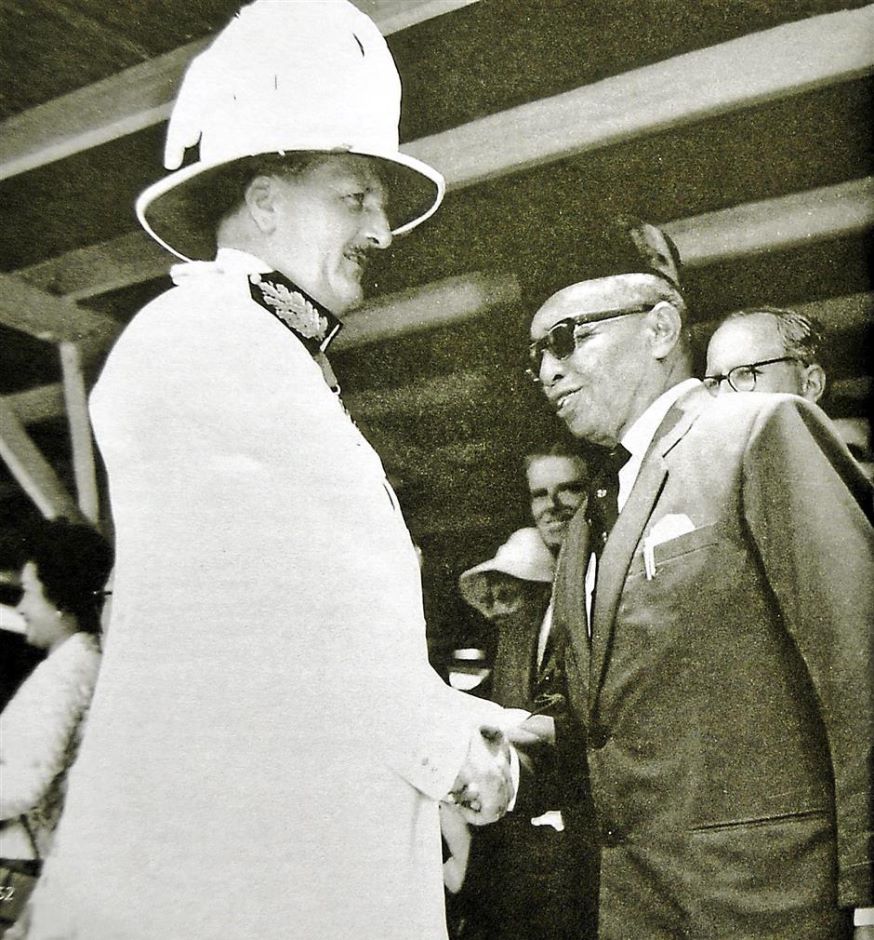
In 1963 Sarawak took its place as part of the newly independent Federation of Malaysia, together with Singapore and North Borneo.
Bertram Brooke dies in England
+- 1965
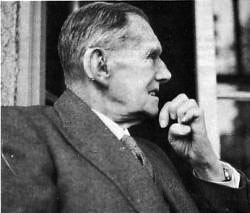
Devastated by Britain's annexation of Sarawak, Bertram took part in the debate in Sarawak’s Council Negri on 15 May 1946 over the Cession Bill and witnessed its passing against a majority of native members against. Banned from Sarawak by the British authorities, he returned to England where he suffered a nervous breakdown. He subsequently stepped back from Sarawak affairs, although he retained his position as his brother’s heir. The rift over cession meant that he was estranged from Vyner but in 1963 they arranged a meeting. It was a meeting that was never fulfilled – Vyner died suddenly at his London home before it could take place. Two years later, Bertram too had died.
The Brooke Trust is established
+- 2010

Encouraged by the support of Anthony Brooke in harnessing this unique heritage for social good, Anthony's son James and two grandsons, Jason and Laurence, established the Brooke Trust, to inspire, inform and enrich communities through socially responsible projects connected with the rich history and heritage of the Brookes.
Anthony Brooke dies in New Zealand
+- 2011

Just a year after the Brooke Trust was formed, Anthony Brooke died in New Zealand at the age of 98. A memorial service took place at Sheepstor, where his ashes were laid beside the Rajahs, followed by a large public memorial held at St Thomas' Cathedral, Kuching.
The Papers of the Brookes of Sarawak are digitised
+- 2012 - 2013

This important collection of private and official papers, correspondence, documentation and images has been deposited at Rhodes House, Oxford, by Brooke family members over five generations (1840 – 1965).
Brooke Gallery at Fort Margherita is announced
+- 2013

The Trust began working closely with the Sarawak Government to develop the Gallery by providing professional design services as well as artefacts from the Brooke Family’s collection. The Gallery would become an experiential journey for the visitor through the birth and development of one of the most romantic and unique independent states ever to exist.
Research begins for Rebuilding Royalist Project
+- 2013

The Trust began research to re-build a replica of Royalist as a platform for experiential learning and outreach programs. We commissioned Will Stirling, maritime historian and classic boat builder, to research and produce drawings for the origianl schooner.
MoU signed as 36,514 Digital Records are presented to Pustaka Negeri Sarawak (State Library)
+- 2013

Tan Sri Datuk Amar (Dr.) Haji Hamid Bugo on behalf of Pustaka Negeri Sarawak and Brooke Trust Director Jason Brooke signed an historic Memorandum of Agreement, outlining a partnership regarding the deposit of materials with Pustaka to make them available for the benefit of Sarawakians in perpetuity.
At the same event, Jason Brooke presented a hard drive containing 36,514 digitised Brooke era records, the originals of which are housed at Rhodes House Library, Oxford. These important records will now be available for the first time in Sarawak, marking a milestone in the availability of primary materials for researchers here.
White Rajah’ feature film is announced
+- 2013

Independent Hollywood film makers Rob Allyn and Simon Fawcett, travelled to Kuching with Brooke Trust Director Jason Brooke, to announce the upcoming feature film biopic on the life of the first Rajah, James Brooke. The group were warmly received by the business community in Kuching, and by State Ministers who offered government support for the film to be made in Sarawak.
Conservation of Fort Margherita is completed
+- 2014
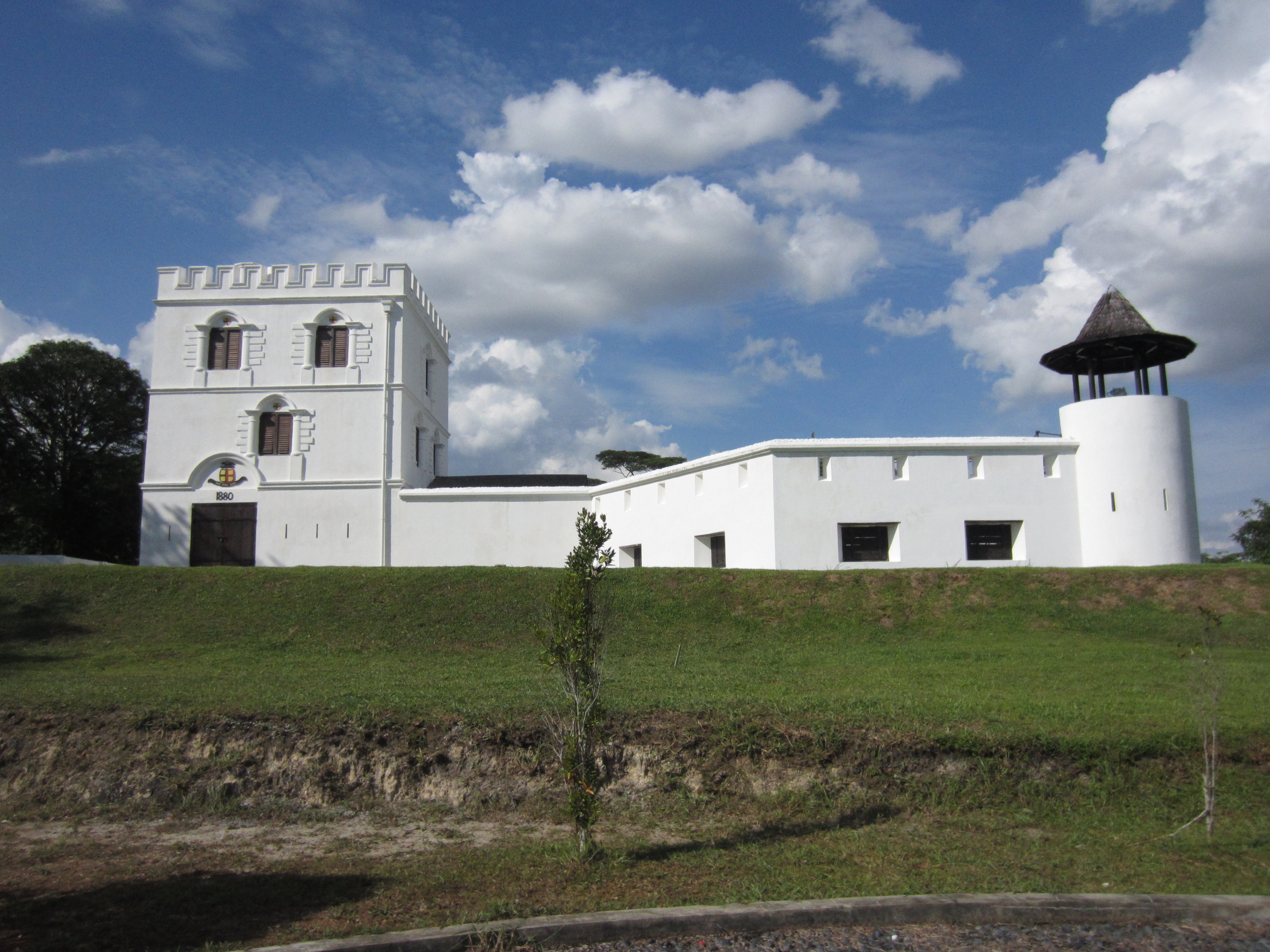
The Fort, recently restored by the National Heritage Department, was handed back to the Sarawak Museum Department ready for the development of The Brooke Gallery.
Rebuilding Royalist research completed
+- 2014

Research, design, project planning and costing have were completed, with further detailed project definition and development of an implementation strategy being the next priorities.
Brooke Gallery design completed
+- 2015
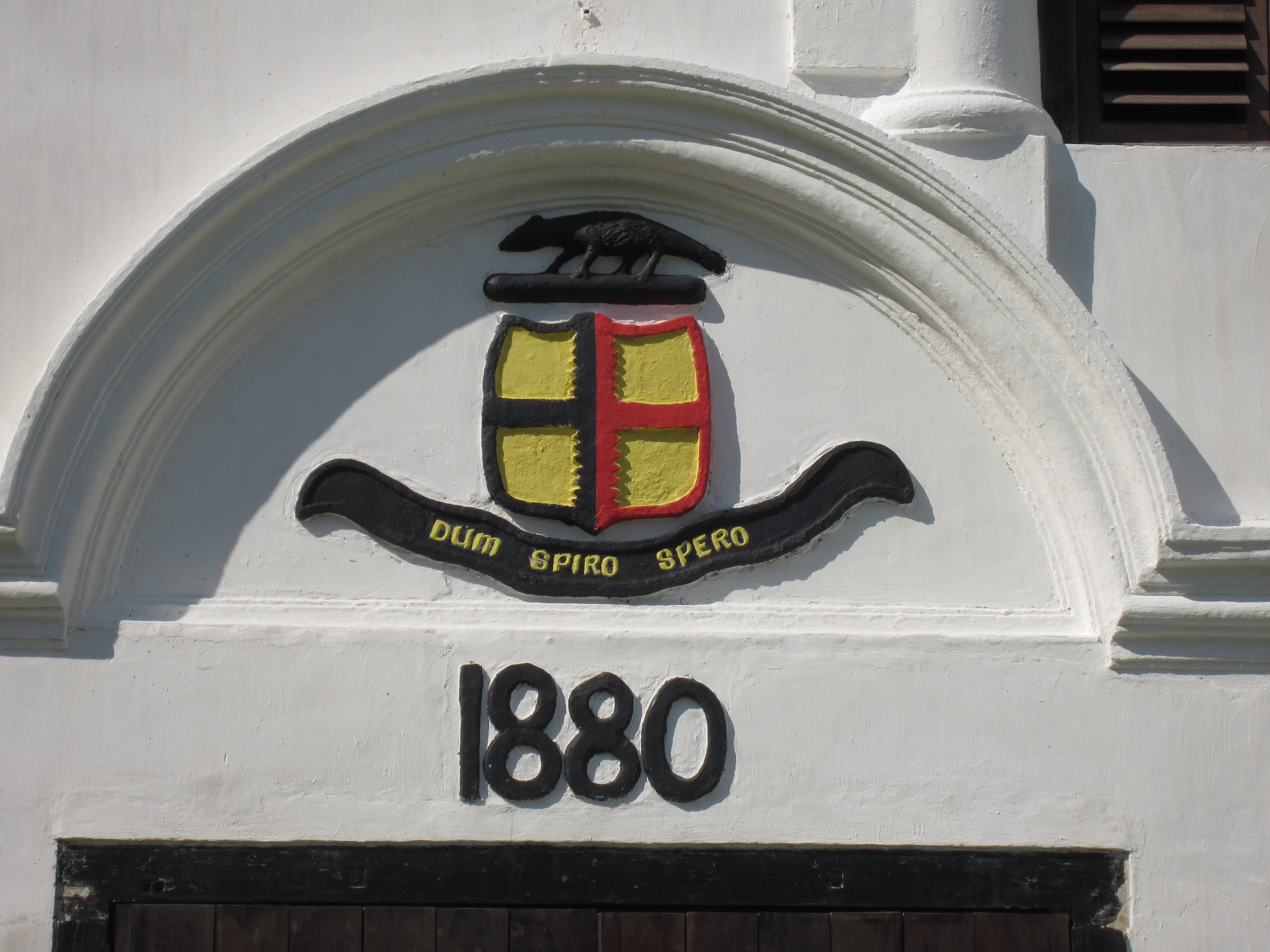
Detailed content, exhibition and graphic design phases were completed, alongside operational planning, with opening to the public planned for early 2016.
Rebuilding Royalist Project to launch…
+- 2016

With detailed research, design, build planning and stakeholder engagement completed, this exciting project is set to formally launch in 2016, the 175th Anniversary of the founding of the State of Sarawak.




